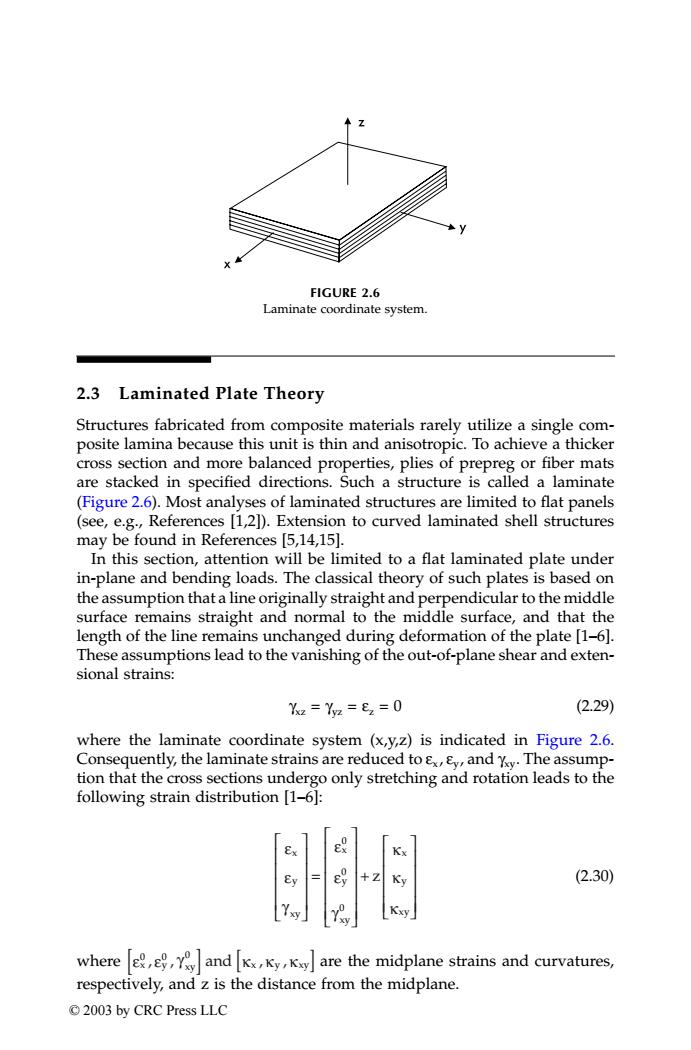正在加载图片...

FIGURE 2.6 Laminate coordinate system. 2.3 Laminated Plate Theory Structures fabricated from composite materials rarely utilize a single com- posite lamina because this unit is thin and anisotropic.To achieve a thicker cross section and more balanced properties,plies of prepreg or fiber mats are stacked in specified directions.Such a structure is called a laminate (Figure 2.6).Most analyses of laminated structures are limited to flat panels (see,e.g.,References [1,2]).Extension to curved laminated shell structures may be found in References [5,14,15]. In this section,attention will be limited to a flat laminated plate under in-plane and bending loads.The classical theory of such plates is based on the assumption that a line originally straight and perpendicular to the middle surface remains straight and normal to the middle surface,and that the length of the line remains unchanged during deformation of the plate [1-6]. These assumptions lead to the vanishing of the out-of-plane shear and exten- sional strains: Yz =Yyz =E2=0 (2.29) where the laminate coordinate system (x,y,z)is indicated in Figure 2.6. Consequently,the laminate strains are reduced tox,y,and Yy.The assump- tion that the cross sections undergo only stretching and rotation leads to the following strain distribution [1-6]: Ex Kx Ey e号 +Z Ky (2.30) Yy】 Kxy whereandare the midplane strains and curvatures, respectively,and z is the distance from the midplane. ©2003 by CRC Press LLC2.3 Laminated Plate Theory Structures fabricated from composite materials rarely utilize a single composite lamina because this unit is thin and anisotropic. To achieve a thicker cross section and more balanced properties, plies of prepreg or fiber mats are stacked in specified directions. Such a structure is called a laminate (Figure 2.6). Most analyses of laminated structures are limited to flat panels (see, e.g., References [1,2]). Extension to curved laminated shell structures may be found in References [5,14,15]. In this section, attention will be limited to a flat laminated plate under in-plane and bending loads. The classical theory of such plates is based on the assumption that a line originally straight and perpendicular to the middle surface remains straight and normal to the middle surface, and that the length of the line remains unchanged during deformation of the plate [1–6]. These assumptions lead to the vanishing of the out-of-plane shear and extensional strains: γxz = γyz = εz = 0 (2.29) where the laminate coordinate system (x,y,z) is indicated in Figure 2.6. Consequently, the laminate strains are reduced to εx, εy, and γxy. The assumption that the cross sections undergo only stretching and rotation leads to the following strain distribution [1–6]: (2.30) where are the midplane strains and curvatures, respectively, and z is the distance from the midplane. FIGURE 2.6 Laminate coordinate system. x y xy x 0 y 0 xy 0 x y xy = +z ε ε γ ε ε γ κ κ κ x 0 y 0 xy 0 [ ] ε ε, , γ and [ ] κκκ x y xy , , TX001_ch02_Frame Page 20 Saturday, September 21, 2002 4:48 AM © 2003 by CRC Press LLC